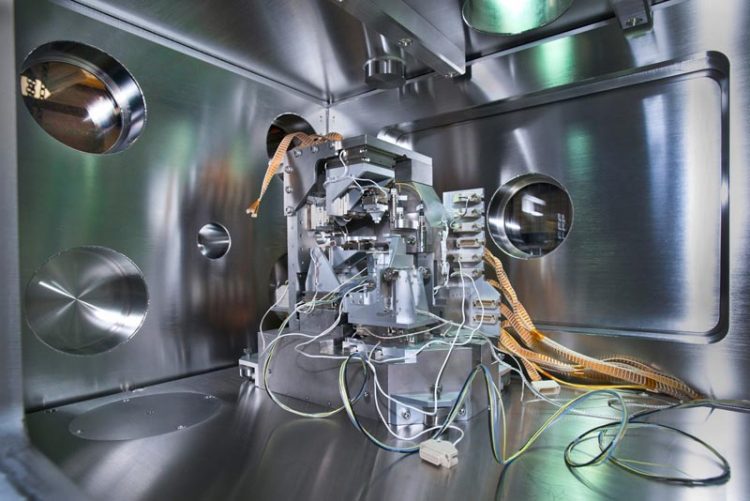A New X-Ray Microscope for Nanoscale Imaging

Brookhaven National Laboratory Multi-layer Laue lens module inside the vacuum chamber of the microscope installed at the Hard X-ray Nanoprobe beamline at NSLS-II.
This groundbreaking instrument, designed to deliver a suite of unprecedented x-ray imaging capabilities for the Hard X-ray Nanoprobe (HXN) beamline, brings researchers one step closer to the ultimate goal of nanometer resolution at NSLS-II, a U.S. Department of Energy Office of Science User Facility.
The microscope manipulates novel nanofocusing optics called multilayer Laue lenses (MLL) — incredibly precise lenses grown one atomic layer at a time — which produce a tiny x-ray beam that is currently about 10 nanometers in size. Focusing an x-ray beam to that level means being able to see the structures on that length scale, whether they are proteins in a biological sample, or the inner workings of a fuel cell catalyst.
The team of scientists who built this microscope aren’t stopping there; they are working toward making the focused x-ray beam spot even smaller in the future. The microscope they developed produces x-ray images by scanning a sample while collecting various x-ray signals emerging from the sample.
Analysis of these signals helps researchers understand crucial information about the materials they are examining: density, elemental composition, chemical state, and the crystalline structure of the sample.
Getting a clear image at this scale requires extremely high stability of the microscope to minimize vibrations and to reduce possible thermal drifts, changes in the microscope due to heat. It requires over twenty piezo motors — very fine motors that produce motion when electric currents are fed into piezo crystals — controlled down to nanometer-scale precision, crammed into a tight space about the size of a coffee maker, to meet its functionalities.
“This instrument incorporates most recent developments in interferometric sensing, nanoscale motion, and position control. Recorded drifts of two nanometers per hour are unprecedented and set a new benchmark for x-ray microscopy systems,” said Evgeny Nazaretski, a physicist at NSLS-II who spearheaded the development of the microscope.
After construction, the MLL module, a key component of the HXN x-ray microscope, was tested at the Diamond Light Source Beamline I-13L for extensive x-ray performance measurements. These measurements confirmed the stability and reliability of the new MLL system. Results are being published in the March issue of the Journal of Synchrotron Radiation.
Hanfei Yan, a co-author of the paper, added, “We are grateful to our collaborators from Argonne National Laboratory who shared their technical expertise from the beginning of this project and also to collaborators from the Diamond Light Source who wholeheartedly supported the x-ray experiments.”
“This instrument is a critical link connecting NSLS-II’s bright x-rays to unprecedented nanoscale x-ray imaging capabilities, which we believe will lead to many groundbreaking scientific discoveries”, stressed Yong Chu, the Group Leader of the Hard X-ray Nanoprobe Beamline at NSLS-II. The HXN beamline and the HXN x-ray microscope are currently being commissioned and will be available for user experiments later this year.
This work is published in the Journal of Synchrotron Radiation.
Brookhaven National Laboratory is supported by the Office of Science of the U.S. Department of Energy. The Office of Science is the single largest supporter of basic research in the physical sciences in the United States, and is working to address some of the most pressing challenges of our time. For more information, please visit science.energy.gov.
Contact Information
Chelsea Whyte
Public Affairs Representative
cwhyte@bnl.gov
Phone: 6313448671
Media Contact
More Information:
http://www.bnl.govAll latest news from the category: Physics and Astronomy
This area deals with the fundamental laws and building blocks of nature and how they interact, the properties and the behavior of matter, and research into space and time and their structures.
innovations-report provides in-depth reports and articles on subjects such as astrophysics, laser technologies, nuclear, quantum, particle and solid-state physics, nanotechnologies, planetary research and findings (Mars, Venus) and developments related to the Hubble Telescope.
Newest articles

A universal framework for spatial biology
SpatialData is a freely accessible tool to unify and integrate data from different omics technologies accounting for spatial information, which can provide holistic insights into health and disease. Biological processes…

How complex biological processes arise
A $20 million grant from the U.S. National Science Foundation (NSF) will support the establishment and operation of the National Synthesis Center for Emergence in the Molecular and Cellular Sciences (NCEMS) at…

Airborne single-photon lidar system achieves high-resolution 3D imaging
Compact, low-power system opens doors for photon-efficient drone and satellite-based environmental monitoring and mapping. Researchers have developed a compact and lightweight single-photon airborne lidar system that can acquire high-resolution 3D…





















